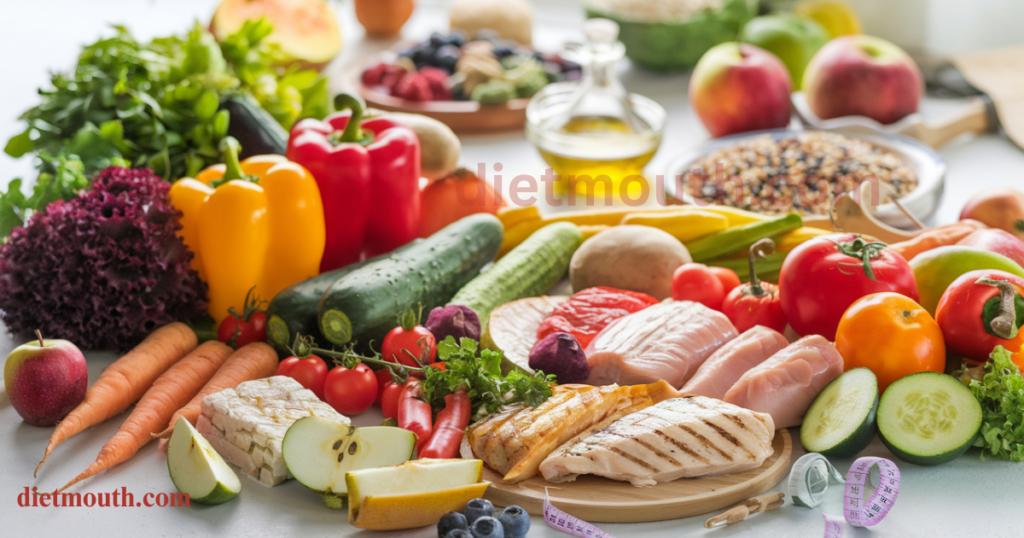A low fat diet focuses on reducing fat intake to promote overall health and well-being. This type of diet can help with weight management, reduce the risk of heart disease, and improve cholesterol levels. Here’s a complete guide to healthy eating on a low-fat diet:
1. Understanding Fat in the Diet
Fat is an essential nutrient, but consuming it in excess—particularly unhealthy fats—can lead to various health issues. The goal of a low-fat diet is to reduce your intake of total fat, especially saturated and trans fats, while maintaining a balanced intake of healthy fats like monounsaturated and polyunsaturated fats.
2. Types of Fat

- Unsaturated Fats (Healthy Fats): These fats help improve cholesterol levels and reduce inflammation. Found in foods like olive oil, avocados, nuts, and seeds.
- Monounsaturated fats: Olive oil, canola oil, and avocados.
- Polyunsaturated fats: Fatty fish, walnuts, and flaxseeds.
- Saturated Fats (Unhealthy Fats): These fats can raise bad cholesterol levels (LDL) and increase the risk of heart disease. Limit your intake of these.
- Found in animal products like fatty cuts of meat, butter, and full-fat dairy products.
- Plant-based oils like palm and coconut oil also contain high amounts of saturated fat.
- Trans Fats (Very Unhealthy Fats): These fats are artificially created through hydrogenation and should be avoided completely. They’re found in processed foods, baked goods, and many fried foods.
3. Benefits of a Low Fat Diet
- Weight Loss: Reducing fat intake helps reduce overall calorie consumption, which can promote weight loss.
- Heart Health: A low-fat diet, particularly one low in saturated and trans fats, can lower blood pressure and improve cholesterol levels, reducing the risk of heart disease.
- Digestive Health: A low-fat diet may be easier on the digestive system, especially for individuals with conditions like gallstones or irritable bowel syndrome (IBS).
4. How to Follow a Low Fat Diet
- Focus on Lean Proteins: Choose lean meats like chicken breast, turkey, and fish. You can also include plant-based proteins like beans, lentils, tofu, and tempeh.
- Opt for Low-Fat Dairy: Select low-fat or fat-free dairy products such as milk, yogurt, and cheese.
- Incorporate Whole Grains: Whole grains like brown rice, oats, quinoa, and whole wheat pasta are great sources of fiber and low in fat.
- Eat Plenty of Fruits and Vegetables: Most fruits and vegetables are naturally low in fat and high in vitamins, minerals, and fiber. Aim to fill half your plate with veggies and fruits at each meal.
- Choose Healthier Cooking Methods: Avoid frying and opt for grilling, baking, steaming, or sautéing with little or no oil.
- Read Nutrition Labels: Look at the fat content on food labels to make informed choices. Choose products with lower total fat, saturated fat, and trans fat.
5. Foods to Include in a Low Fat Diet

- Fruits and Vegetables: All fresh, frozen, or canned without added fats. Examples include apples, oranges, spinach, carrots, broccoli, and berries.
- Whole Grains: Brown rice, quinoa, barley, whole wheat bread, and oatmeal.
- Lean Protein: Skinless poultry, fish, legumes (beans, lentils), tofu, and tempeh.
- Low-Fat Dairy: Skim milk, low-fat yogurt, and reduced-fat cheese.
- Healthy Fats: Avocados, nuts, seeds, and olive oil (in moderation).
- Legumes: Beans, lentils, and peas.
6. Foods to Limit or Avoid
- Fatty Meats: Bacon, sausage, processed meats, and high-fat cuts of beef, pork, and lamb.
- Full-Fat Dairy: Whole milk, cream, butter, and full-fat cheese.
- Fried Foods: Fried chicken, fries, and other deep-fried items.
- Baked Goods: Pastries, cakes, cookies, and other items made with butter, margarine, or shortening.
- Processed Snacks: Chips, snack cakes, and crackers that contain trans fats.
- High-Fat Condiments: Mayonnaise, creamy dressings, and certain dips.
7. Sample Meal Plan for a Low Fat Diet

Breakfast:
- Oatmeal made with water or skim milk, topped with fresh berries and a sprinkle of flaxseeds.
- A cup of black coffee or tea.
Lunch:
- Grilled chicken salad with mixed greens, cucumbers, tomatoes, and a low-fat vinaigrette dressing.
- A side of whole wheat crackers.
Snack:
- A handful of almonds or a piece of fruit, such as an apple or banana.
Dinner:
- Baked salmon with lemon and herbs, served with steamed vegetables and quinoa.
Dessert:
- Fat-free yogurt with a drizzle of honey and sliced strawberries.
8. Tips for Success
- Meal Prep: Plan and prepare meals ahead of time to avoid reaching for unhealthy, high-fat snacks.
- Moderation: Even healthy fats should be consumed in moderation. While they are beneficial, they are still calorie-dense.
- Stay Hydrated: Drink plenty of water throughout the day to support overall health.
- Exercise: Pair your low-fat diet with regular physical activity for optimal health benefits.
9. Common Myths About Low Fat Diets
- Low-fat means no flavor: You can still enjoy delicious meals on a low-fat diet by using herbs, spices, and healthy cooking methods.
- All fats are bad: Not all fats are harmful. Healthy fats are essential for your body.
- Low-fat diets lead to muscle loss: With proper protein intake, a low-fat diet does not cause muscle loss.
10. Conclusion
A low-fat diet can be a healthy, sustainable way to improve overall health, manage weight, and reduce the risk of chronic diseases. By focusing on lean proteins, whole grains, and plenty of fruits and vegetables, while limiting unhealthy fats, you can enjoy nutritious and balanced meals that support your well-being.
Remember, it’s important to consult with a healthcare professional or dietitian before making significant dietary changes, especially if you have any underlying health conditions.
Also Read: What Is The DASH Diet For Hypertension And How Does It Work?
